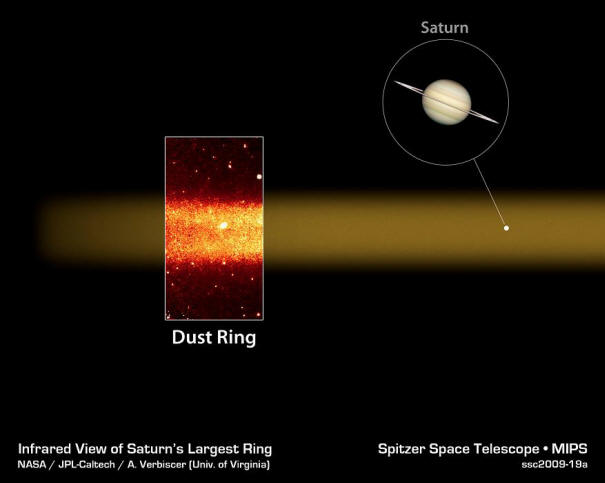|
|
|

Image Credit: NASA/JPL/Caltech/A. Verbiscer,
University of Virginia.
Saturn Loosens its Belt
May 12, 2010
Another ring, larger than
anything expected, has been
discovered around Saturn.
On August 25, 2003, NASA launched
the
Spitzer Space Telescope into an
Earth-trailing, heliocentric orbit
as part of the Great Observatories
program. The Hubble Space Telescope,
the Chandra X-ray observatory, and
the Compton Gamma-Ray Observatory
are the other three space-based
platforms in the program, designed
to resolve distant objects at
various wavelengths. Spitzer is the
infrared partner in the
quartet—seeing objects in the 5.3 to
40 micron wavelength range.
One of the most intriguing
new discoveries from Spitzer is
the presence of another ring around
Saturn, something completely
unexpected. The new ring is canted
27 degrees from the main ring plane
and is in a retrograde orbit around
the giant gas planet. It is also
quite large. As Anne Verbiscer from
the University of Virginia
commented: "This is one supersized
ring. If you could see the ring, it
would span the width of two full
moons' worth of sky, one on either
side of Saturn."
The vast belt of material ends at 18
million kilometers from the planet
and is 12 million kilometers wide.
It is also much thicker than the
main rings: 2.5 million kilometers
from top to bottom. The thickness
measurement is an approximation,
since the ring is so diffuse.
One of Saturn's moons, Phoebe,
orbits within the new ring and is,
itself, circling its parent in a
retrograde orbit. Some scientists
speculate that the ring is generated
from Phoebe as its surface ices are
eroded by impacts over millions of
years.
Phoebe is another tiny moon, 220
kilometers in diameter, half the
size of Enceladus. Its gravitational
acceleration is a mere .05 meters
per second squared. The majority of
Saturn's other moons are highly
reflective of visible light, but
Phoebe is as black as coal, making
it one of the
darkest objects in the Solar
System.
NASA scientists describe Phoebe
as "very strange" and probably a
captured moon.
Many of Saturn's moons seem to be
partially covered with reddish-black
"soot."
Iapetus,
Dione and
Hyperion are all dusted with the
same dark reddish substance. In
previous Picture of the Day
articles, it was theorized that they
were darkened by particles ejected
from
Phoebe.
The plasmasphere of Saturn
electrifies its environment, causing
dark-mode plasma discharges to
impinge on its family of moons.
Enceladus, Dione and Tethys are
all electrically active, flinging
vast quantities of charged particles
into space. Each moon is connected
to its parent and to one another
through cosmic electrical circuits.
Planets with magnetic fields can
trap fast-moving particles to form
giant electrified clouds, more
accurately called electric currents.
NASA scientists have noted that
Saturn's magnetic field bends around
Enceladus "due to electric currents
generated by the interaction of
atmospheric particles and the
magnetosphere of Saturn." Further
flattening of the plasma torus on
the sunward side demonstrates an
electrical (not mechanical) effect
is occurring between Saturn and the
Sun.
Bodies immersed in plasma are not
isolated, they are connected by
circuits, just as Phoebe is
connected to Saturn. Most of the
time they are not in equilibrium
because they are in unstable
conditions. The majority of them are
moving across the plasma filaments
that exist in the Solar System and
in the plasmaspheres around planets.
Currents in plasma contract into
filaments and the force between
filaments is linear, so the
electromagnetic fields created by
them are the most powerful
long-range attractors in the
Universe.
The simplest, most straightforward
explanation for the new ring is
charged particles spewing from
Saturn's moons. There is no need to
conjure numerous impact events over
the eons. We predict that
investigation over time will show
that the active sources of charged
particle streams from Enceladus,
Tethys, Dione, and Phoebe all move
across their surfaces.
Stephen Smith
|
|
|
|
|
|
|
|
|
YouTube video, first glimpses of Episode Two in the "Symbols of an Alien Sky"
series.
|
|
|
|
|
|
|
Three ebooks in the Universe Electric series are
now available. Consistently
praised for easily understandable text and exquisite graphics.
|
|
|
|
|
|
|
|
|
|







